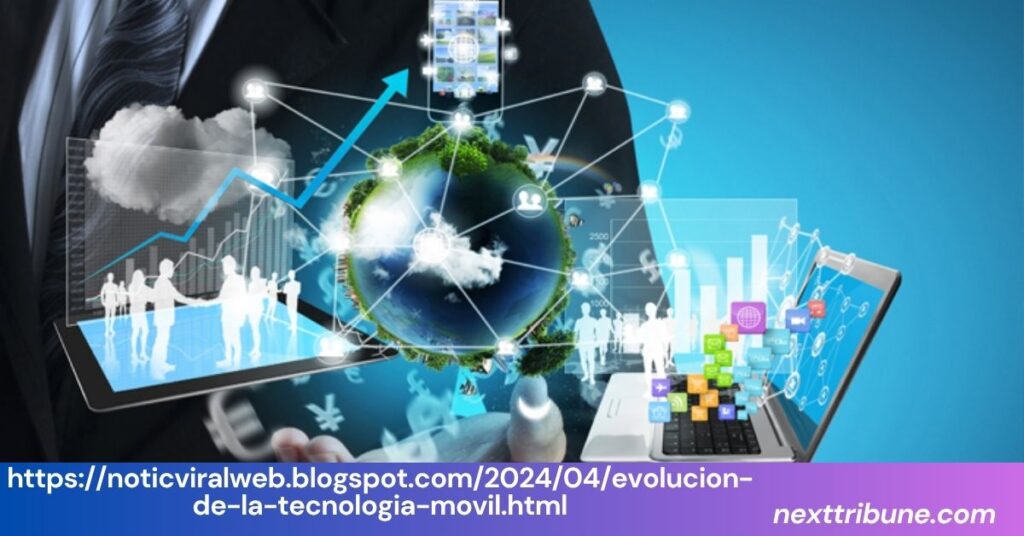
Mobile technology has evolved at an extraordinary pace over the last few decades, transforming the way we communicate, work, and live. From the early days of bulky mobile phones to the advanced smartphones and 5G networks of today, mobile technology has continuously redefined the way we interact with the world. This article delves into the evolution of mobile technology, highlighting key innovations, trends, and the future possibilities that continue to shape the landscape. We will specifically look at the insights provided in “https://noticviralweb.blogspot.com/2024/04/evolucion-de-la-tecnologia-movil.html” to explore how mobile technology is evolving and the implications this has on both consumers and businesses alike.
Early Developments: The Birth of Mobile Technology
The concept of mobile technology can be traced back to the 1940s, though it wasn’t until the 1970s that the first mobile phone became a reality. Early mobile phones were cumbersome, expensive, and had limited capabilities.
The First Mobile Phones
The first mobile phone, the Motorola DynaTAC, was unveiled in 1973. It weighed a whopping 2.5 pounds, was about 10 inches tall, and cost around $4,000. Despite its bulky design, it allowed people to make calls while on the go—an innovation that would eventually revolutionize communication. However, it wasn’t until the 1980s and 1990s that mobile phones became widely available to the general public, though they were still relatively expensive and bulky by today’s standards.
Technological Limitations
Early mobile phones were limited to making voice calls only. The network infrastructure at the time was analog, meaning the signal was prone to interference, limiting the quality of communication. Furthermore, the devices were not mobile in the sense that we think of today—users had to be relatively close to a service tower to make a call, and long-distance calls were costly and unreliable.
The Advent of Digital Mobile Networks: A Game Changer
The mobile phone revolution took off when the digital mobile networks began replacing the old analog systems in the 1990s. Digital networks allowed for clearer calls and the introduction of new mobile services that would go on to shape the industry.

The Introduction of GSM
The introduction of the Global System for Mobile Communications (GSM) in the 1990s was a key turning point in mobile technology. GSM brought several benefits, including clearer, more reliable calls and the ability to send text messages. This was the beginning of the shift from voice-only communication to the multi-functional devices we have today.
The Rise of SMS
The Short Message Service (SMS), or texting, became a major part of mobile communication in the late 1990s. With SMS, mobile phones gained a new capability that allowed users to send short, written messages. Texting quickly became a popular method of communication, particularly among younger audiences. This marked a shift in the way people used their phones, as they were no longer just for voice calls.
Also Read: Aponeyrvsh: Exploring the Fusion of Movement and Innovation
The Smartphone Revolution: A New Era of Mobile Computing
The early 2000s saw the rise of smartphones—devices that combined the functionality of a mobile phone with the power of a computer. The introduction of the iPhone in 2007 marked the beginning of a new era for mobile technology, changing the way people interacted with their devices and with each other.
The Integration of Computing Power
Smartphones were revolutionary because they integrated computing power into a portable form factor. Early mobile phones had basic features, like calling and texting, but smartphones allowed for web browsing, email, and multimedia consumption. The processing power of smartphones grew exponentially, enabling users to access a wealth of information and perform a wide range of tasks from their devices.
Touchscreen Technology
One of the key innovations that changed the smartphone landscape was the introduction of touchscreen technology. Physical keyboards became obsolete, replaced by intuitive, full-touch screens. This shift made it easier to navigate through apps, browse the internet, and interact with devices in a more natural way.
The Rise of 4G and 5G Networks: Unprecedented Connectivity
One of the most significant advancements in mobile technology has been the improvement in internet speeds, starting with 4G and moving toward the current 5G networks. These advancements have greatly enhanced mobile experiences, allowing for faster downloads, higher-quality streaming, and seamless browsing.
Faster Internet Speeds
4G technology brought significant improvements to mobile data speeds, enabling users to download files, stream high-definition videos, and use mobile apps without interruptions. The adoption of 4G networks brought a new era of mobile connectivity, driving innovations in services like mobile banking, video calls, and social media platforms.
The Impact of 5G
The arrival of 5G has ushered in even faster internet speeds and reduced latency. This next-generation network enables real-time communication, such as remote surgery, autonomous driving, and the widespread adoption of the Internet of Things (IoT). 5G networks promise to revolutionize industries, enhance mobile gaming, and improve virtual and augmented reality experiences.
The Impact of Mobile Apps: Revolutionizing Industries
Mobile applications have transformed how businesses interact with consumers, opening new avenues for marketing, sales, and customer service.
Mobile E-Commerce
The rise of mobile apps has drastically changed the retail landscape. Shopping apps such as Amazon, eBay, and e-commerce platforms like Shopify have enabled businesses to reach customers directly through their smartphones. Consumers can browse products, make purchases, and track deliveries—all from the palm of their hand. This shift has played a key role in the boom of mobile commerce, or m-commerce, and continues to evolve with the introduction of mobile payment systems like Apple Pay and Google Wallet.
Also Read: Transds: Bridging Boundaries for Complex Problem Solving
Mobile Banking and Finance
Mobile technology has made financial transactions more accessible and secure. Banking apps allow users to transfer funds, check account balances, and even apply for loans, all without visiting a bank branch. The rise of mobile payment services, such as PayPal and Venmo, has enabled seamless peer-to-peer transactions, further emphasizing the importance of mobile technology in financial services.
The Internet of Things (IoT): Connecting Devices for a Smarter World
The Internet of Things (IoT) refers to the growing network of connected devices that communicate with each other to enhance functionality and efficiency. Mobile devices are central to the IoT ecosystem, serving as hubs for controlling and monitoring connected devices.
What is IoT?
IoT enables everyday objects to collect and exchange data over the internet. Smart thermostats, fitness trackers, refrigerators, and security cameras are just a few examples of IoT-enabled devices. These devices rely on mobile phones to function, allowing users to control them remotely via apps.
Mobile-First IoT Solutions
Mobile technology is increasingly the driving force behind IoT. Through apps, users can manage their homes, track their health, or interact with smart cities. The future of IoT depends on the seamless integration of mobile technology, making our lives smarter and more connected.
Mobile Technology in Healthcare: Transforming Patient Care
The healthcare industry has seen dramatic improvements thanks to mobile technology. Mobile health (mHealth) applications are changing the way we monitor, diagnose, and treat health conditions.
Remote Patient Monitoring
With mobile devices, healthcare professionals can monitor patients’ health metrics in real-time, even from a distance. Wearable devices such as fitness trackers, heart rate monitors, and glucose meters can transmit data to medical professionals, enabling more proactive healthcare management.
Telemedicine
Telemedicine, facilitated by mobile technology, allows patients to consult with doctors remotely. This became especially important during the COVID-19 pandemic, when social distancing measures made in-person consultations difficult. Virtual consultations are now a common part of healthcare services worldwide, with many doctors and patients preferring the convenience and safety of online consultations.
The Future of Mobile Technology: AI, AR, and Beyond
The future of mobile technology is bright, with advancements in artificial intelligence (AI), augmented reality (AR), and other cutting-edge technologies.
AI Integration
AI is playing an increasingly important role in mobile technology, from virtual assistants like Siri and Google Assistant to predictive text and personalized recommendations. AI enables smartphones to learn from user behavior and improve user experience by anticipating needs and automating tasks.
Augmented Reality (AR)
AR is another technology that is expected to shape the future of mobile technology. Apps that integrate AR technology, such as Pokémon GO and IKEA’s augmented shopping experience, allow users to interact with their surroundings in a virtual manner. In the future, AR could revolutionize shopping, education, gaming, and even healthcare.
Challenges in Mobile Technology: Security and Privacy Concerns
While mobile technology has revolutionized communication and access to information, it also brings challenges, particularly related to privacy and security.
Data Privacy
With smartphones collecting vast amounts of personal data, privacy concerns have become a significant issue. Mobile apps track location, financial transactions, and personal preferences, raising concerns about how this data is used and who has access to it.
Cybersecurity
Mobile devices are increasingly targeted by cybercriminals. With the rise of mobile banking and shopping, smartphones have become a prime target for hacking, phishing, and malware attacks. This highlights the need for stronger mobile security measures, such as biometric authentication and encryption.
Also Read: VIPRow Alternative : Free Sports Streaming
Conclusion: Mobile Technology’s Enduring Impact
The evolution of mobile technology has been nothing short of extraordinary. From the first mobile phones to the revolutionary smartphones we use today, mobile technology has continually reshaped how we communicate, work, and live. As we move into the future, mobile technology will continue to evolve, driven by innovations in AI, AR, 5G, and IoT. These advancements promise to make our lives even more connected, convenient, and smarter.
The insights provided by “https://noticviralweb.blogspot.com/2024/04/evolucion-de-la-tecnologia-movil.html” are essential for understanding the ongoing transformation in mobile technology, and the future holds exciting possibilities that will likely continue to shape the way we interact with the digital world.
FAQs about https://noticviralweb.blogspot.com/2024/04/evolucion-de-la-tecnologia-movil.html
What is the first mobile phone ever created?
The first mobile phone, the Motorola DynaTAC 8000X, was introduced in 1983. It was large, heavy, and expensive, but it paved the way for modern mobile devices.
How does 5G differ from 4G?
5G offers significantly faster speeds, lower latency, and greater capacity compared to 4G. It also supports more devices and enables advancements in IoT, autonomous vehicles, and augmented reality.
What is the role of mobile technology in education?
Mobile technology in education enables access to learning materials, online courses, and collaboration tools, enhancing educational opportunities for students worldwide.
How has mobile technology impacted business operations?
Mobile technology has enabled businesses to streamline communication, increase productivity, and reach customers globally through mobile apps, websites, and marketing strategies.
What can we expect from mobile technology in the next decade?
We can expect more immersive experiences through AR/VR, advancements in AI for smarter devices, faster internet speeds, and more seamless integration of mobile devices with everyday objects through IoT.



